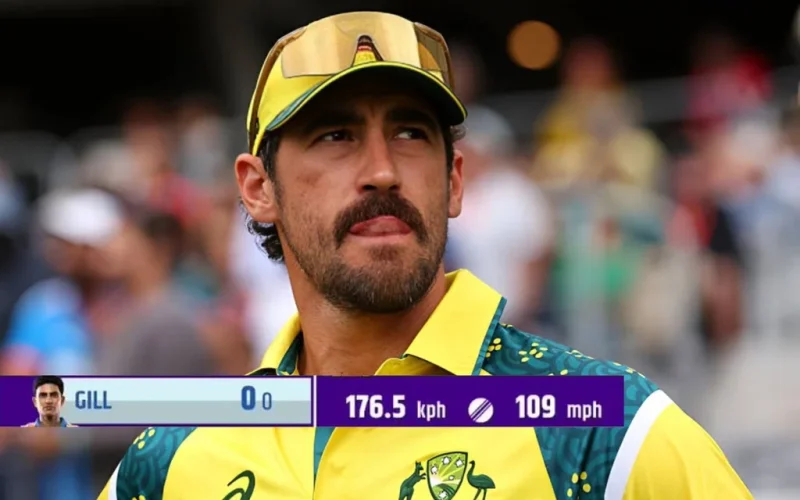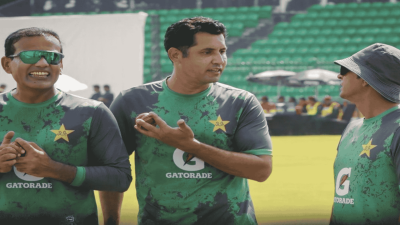PERTH: The cricket world was sent into a brief frenzy on Sunday after Australia’s left-arm pace spearhead Mitchell Starc was captured bowling a delivery clocked at a staggering 176.5 km/h during the first One Day International (ODI) against India at the Perth Cricket Stadium.
The incident occurred when Starc unleashed his opening delivery to Indian captain Rohit Sharma, leaving commentators, spectators, and fans across the globe in disbelief. The reading on the speed gun appeared to show a record-shattering figure—well beyond anything ever officially recorded in the sport’s history.
However, the excitement was soon tempered when match officials and technical teams confirmed that the speed reading was the result of a malfunctioning radar system. Cricket Australia’s technical analysts clarified that an error in the speed gun calibration led to the false reading. Starc’s actual delivery speed was within his usual range of 145–150 km/h, which, while still blistering fast, did not come close to the all-time record.
Shoaib Akhtar’s Unbroken Record Still Stands
The confusion reignited discussion about the fastest delivery ever recorded in international cricket, a record that has stood unchallenged for more than two decades.
Pakistan’s legendary fast bowler Shoaib Akhtar, famously known as the “Rawalpindi Express,” set the benchmark during the 2003 ICC Cricket World Cup in a match against England. His thunderous delivery to England’s Nick Knight clocked in at 161.3 km/h (100.23 mph), making him the first and only bowler to officially break the 100 mph barrier.
Since then, several of the game’s fastest bowlers — including Brett Lee, Shaun Tait, and Mitchell Starc himself — have come close, with recorded speeds exceeding 160 km/h. Yet none have surpassed Akhtar’s record, which remains a symbol of raw pace and bowling aggression in cricket folklore.
Starc’s Spell Dominates Despite False Alarm
Despite the temporary confusion over the radar reading, Starc’s performance was a reminder of why he remains one of the most feared fast bowlers in the modern era.
Opening the bowling for Australia, he struck early, removing Virat Kohli for a duck, a wicket that shifted the momentum firmly in Australia’s favor. He bowled with his trademark pace, late swing, and accuracy, maintaining a probing line that kept Indian batters on the back foot.
Starc finished his spell with 6 overs, 22 runs, and 1 wicket, an economy rate of just 3.66 — impressive figures given the shortened, high-intensity format of the rain-affected match.
India’s Struggle in a Rain-Hit Contest
Earlier in the day, the match was reduced to 26 overs per side due to heavy showers in Perth. Batting first, India managed to post 137 runs, thanks largely to KL Rahul’s composed knock of 38 runs off 31 balls, featuring two boundaries and two towering sixes.
None of the other Indian batters could build significant partnerships as Australia’s bowling attack, led by Starc and supported by Josh Hazlewood and Nathan Ellis, consistently applied pressure.
The Truth Behind the Viral Speed Reading
When the speed gun displayed “176.5 km/h,” social media erupted instantly. Within minutes, clips of Starc’s delivery went viral, with fans and analysts speculating that the Australian quick had smashed Shoaib Akhtar’s record.

Cricket Twitter (now X) was flooded with posts such as:
“Did Starc just break the sound barrier?!”
“Shoaib Akhtar’s 161.3 km/h record finally beaten?”
However, as official clarification poured in, it became evident that the number was a technical glitch, likely caused by environmental interference or radar calibration issues.
The ICC’s official match data later confirmed that Starc’s fastest legitimate delivery of the match was clocked at 149.9 km/h — quick enough to rattle top-order batters but far from record-breaking territory.
The Legacy of Pace in Modern Cricket
Mitchell Starc has consistently ranked among the fastest bowlers in contemporary cricket, joining the elite company of Brett Lee, Shaun Tait, Jofra Archer, and Anrich Nortje — all of whom have exceeded the 155 km/h mark.
However, Shoaib Akhtar’s record continues to serve as the gold standard for speed bowling. His 161.3 km/h rocket, bowled more than 20 years ago, is often cited not just for its speed but for the combination of control, aggression, and intimidation that defined his bowling.
For Akhtar, the record symbolizes more than just raw power — it represents an era when Pakistan produced some of the most fearsome fast bowlers the game has ever seen.
Playing XIs
India: Rohit Sharma (c), Shubman Gill, Virat Kohli, Shreyas Iyer, KL Rahul (wk), Axar Patel, Washington Sundar, Nitish Reddy, Harshit Rana, Arshdeep Singh, Mohammed Siraj
Australia: Travis Head, Mitchell Marsh (c), Matt Short, Josh Philippe (wk), Matt Renshaw, Mitch Owen, Cooper Connolly, Mitchell Starc, Nathan Ellis, Matt Kuhnemann, Josh Hazlewood
In other news also read about Pakistan Opt to Bat First, Eye Series Whitewash Against South Africa in Final Test









